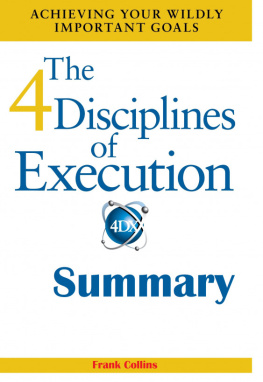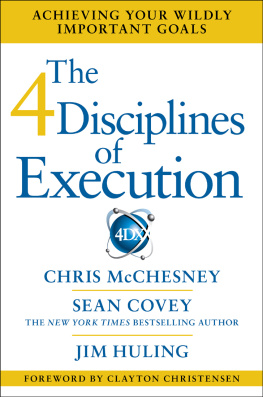Copyright Page
The 4 Disciplines of Execution Summary
By Frank. Collins
Copyright 2013 Frank. Collins Collins Publishers
Smashwords edition.
This ebook is licensed for your personal enjoyment only. Thisebook may not be re-sold or given away to other people. If youwould like to share this book with another person, please purchasean additional copy for each reader. If youre reading this book anddid not purchase it, or it was not purchased for your use only,then please return to Amazon Digital Services, Inc and purchaseyour own copy. Thank you for respecting the hard work of thisauthor.
The 4 Disciplines of Execution Summary
Introduction.
Do you remember the last major initiative you watched die inyour organization? Did it go down with a loud crash? Or was itslowly and quietly suffocated by other competing priorities? By thetime it finally disappeared, it's likely no one even noticed. Whathappened? The " whirlwind " of urgent activityrequired to keep things running day-to-day devoured all the timeand energy you needed to invest in executing your strategy fortomorrow! The 4 Disciplines of Execution can change all of thatforever.
The 4 Disciplines of Execution ( 4DX ) is a simple, repeatable, andproven formula for executing on your most important strategicpriorities in the midst of the whirlwind. By following the 4Disciplines, focusing on the wildly important, acting on leadmeasures, keeping a compelling scoreboard, and creating a cadenceof accountability, leaders can produce breakthrough results. 4DX isnot theory. It is a proven set of practices that have been testedand refined by hundreds of organizations and thousands of teamsover many years.
When a companyor an individual adheres to these disciplines, they achieve superbresults regardless of the goal. 4DX represents a new way ofthinking and working that is essential to thriving in today'scompetitive climate.
Here we will discuss what the 4Disciplines of Execution are and why they work.
How to execute your strategic priorities and get results. Howto effect change in human behavior to achieve your goals. How toinstall the 4DX in your team and organization.
The Real Problem with Execution
If youreleading people right now, you are probably trying to get them to dosomething different. Whether you lead a small work team or a wholecompany, a family or a factory, no significant result is achievableunless people change their behavior. To be successful, you willneed their commitment. Getting the kind of commitment that willendure in the midst of the daily grind is not easy.
When you execute a strategy that requires a lasting change inthe behavior of other people, you're facing one of the greatestleadership challenges you will ever meet. With the 4 Disciplines ofExecution ( 4DX ),you are implementing a set of proven practices that meet thatchallenge successfully every time. The real enemy of execution isthe whirlwind, the massive amount of energy that's necessary justto keep your operation going on a day-to-day basis. The 4Disciplines aren't designed for managing your whirlwind, but forexecuting your most critical strategy in the midst of yourwhirlwind.
THE 4 DISCIPLINES OF EXECUTION
Discipline 1: Focus on the Wildly Important
Focus yourfinest effort on one or two goals that will make all thedifference, instead of giving mediocre effort to dozens of goals.Execution starts with focus. Without it, the other threedisciplines won't be able to help you.
Identifying Your Wildly Important Goals
A wildly important goal ( WIG ) is a goal that can make all thedifference. You're going to commit to apply a disproportionateamount of energy to it, the estimated 20 percent that is not usedup in the whirlwind. In determining your WIG, don't ask What'smost important? Instead, begin by asking If every other area of our operation remained at its currentlevel of performance, what is the one area where change would havethe greatest impact? Whether your WIGcomes from within the whirlwind or outside it, your real aim is notonly to achieve it, but also to then make the new level ofperformance a natural part of your team's operation.
Focusing the Organization
Here are fourrules to help you narrow the focus of your entire organization:
Rule #1:
No teamfocuses on more than two WIGs at the same time. The key is not tooverload any single leader, team or individual performer.
Rule #2:
The battlesyou choose must win the war. The sole purpose of WIGs at lowerlevels in the organization is to help achieve the WIGs at higherlevels.
Rule #3:
Senior leaderscan veto, but not dictate. While the senior leaders willundoubtedly determine the top-level WIG, they must allow theleaders at each level below to define the WIGs for their teams.
Rule #4:
All WIGs musthave a finish line in the form of from X to Y by when. Every WIG atevery level must contain a clearly measurable result, as well asthe date by which that result must be achieved.
Discipline 2: Act on the Lead Measures
While a lagmeasure tells you if youve achieved the goal, a lead measure tellsyou if you are likely to achieve the goal. For example, while youcan't control how often your car breaks down on the road (a lagmeasure), you can certainly control how often your car receivesroutine maintenance (a lead measure). And the more you act on thelead measure, the more likely you are to avoid that roadsidebreakdown.
We call themlag measures because by the time you get the data the result hasalready happened. A lead measure is predictive, meaning that if thelead measure changes, you can predict that the lag measure willalso change. A lead measure is also influenceable; it can beinfluenced by the team. It's the data on lead measures that enablesyou to close the gap between what you know your team should do andwhat they are actually doing. Without lead measures, you are leftto try to manage to the lag measures, an approach that seldomproduces significant results.
Defining and Tracking Lead Measures
OaklandAthletics General Manager Sandy Alderson and his assistant managerBilly Beane brought together the best thinkers they could find onthe subject: What produces wins? The answer: the highest number ofruns. What are the lead measures that create a run? They discoveredthat the mighty sluggers were often not all that productive.
The mostproductive players were the ones who could just get on base. Theycould score runs much more reliably than the power hitters whocommanded astronomical salaries. What Beane did was to track theon-base record of players across the league and then recruit fromthose who were very good at getting on base.
For a decade, the Oakland A's maintained the fifth bestrecord in Major League Baseball while ranking 24th in playersalaries. The Oakland management team reframed the game by actingon the lead measures that produce wins. If you are serious aboutyour WIG, then you must create a way to track your lead measures.Without data, you can't drive performanceon the lead measures; without lead measures, you don't haveleverage.
Lead Measures and Engagement
Coming up withthe right lead measures is really about helping everyone seethemselves as strategic business partners and engaging them indialogue about what can be done better or differently in order toachieve the WIGs. A good example is the advertising department ofthe Savannah Morning News.
Their WIG wasto close a serious revenue gap. Their focus was spread across somany initiatives that they had taken their eyes off of their mainproduct. Everything changed when they started practicing Discipline2: Act on the lead measures. In the weekly WIG sessions, peoplecommitted to hit a certain number of new customer contacts,reactivation calls, and upsell offers. The newspaper closed itsrevenue gap and shot past its goals for the year.
Next page






